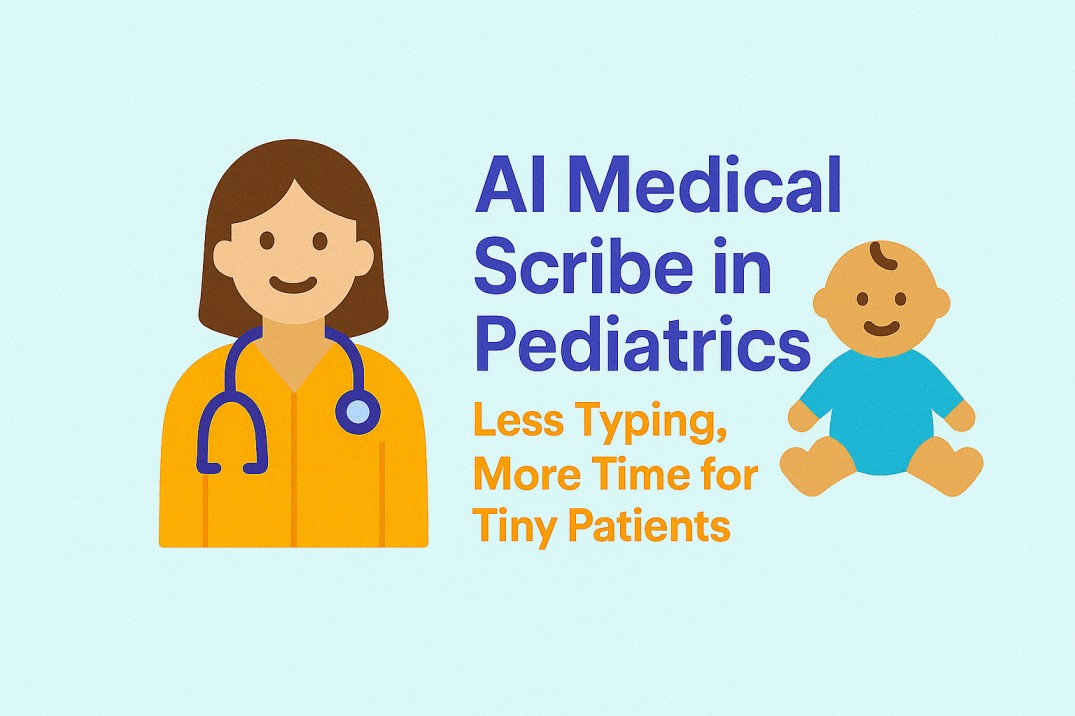Updated on: July 2, 2025
In pediatric care, every moment matters — whether you’re assessing developmental milestones, counseling anxious parents, or treating a toddler’s fever. Yet for many pediatricians, those moments are overshadowed by the time-consuming burden of clinical documentation.
Enter the AI medical scribe.
The rise of ambient and voice-enabled AI medical scribes in pediatrics is transforming how pediatricians work — streamlining EHR workflows, reducing after-hours charting, and giving doctors what they truly need: more face-to-face time with children and families.
DocScrib, a cutting-edge AI medical scribe solution, leads this transformation with pediatric-specific intelligence, EHR integration, and HIPAA-compliant design — helping clinicians work smarter, not harder.
Why Pediatricians Are Turning to AI Medical Scribes
1. Pediatric Workflows Are Unique — And Demanding
Pediatric documentation isn’t just scaled-down adult medicine. It involves:
-
Growth charts and percentile tracking
-
Immunization schedules and catch-ups
-
Well-child visits with age-specific templates
-
Frequent family and guardian communication
-
Developmental screenings and milestone logs
Each visit can generate complex and time-intensive charting — even for routine checkups. AI scribes automate that process by listening in real-time and generating structured, clinically relevant notes.
2. Reduce Charting Time and Reclaim Clinical Hours
Studies show that pediatricians spend up to 2 hours on documentation for every hour of face-to-face care. The result? Burnout, administrative fatigue, and missed family time.
With DocScrib, AI captures and transcribes the entire patient interaction, generates SOAP notes, and pre-populates sections like:
-
Subjective complaints from the parent or child
-
Objective findings (e.g., normal pediatric physical exams)
-
Assessment with ICD-10-ready clinical reasoning
-
Plan, including follow-up, vaccinations, and anticipatory guidance
💡 “Using DocScrib, our pediatricians reduced documentation time by over 65% and reported significantly better engagement during visits.” – DocScrib User Case Study
How DocScrib Enhances Pediatric Visits
| Feature | Benefit for Pediatricians |
|---|---|
| Age-specific templates | Automated well-visit formats for each milestone (e.g., 2mo, 6mo, 2yr) |
| Growth chart syncing | Inputs height, weight, and head circumference directly into EHR |
| Parent-friendly summaries | Auto-generated education handouts from plan sections |
| Speech-to-note capture | Talk naturally; DocScrib listens, understands, and writes |
| HIPAA-secure AI engine | Keeps child health records private and protected |
DocScrib’s pediatric module is trained on hundreds of thousands of pediatric encounters, ensuring it speaks your language — from “toddler tantrums” to “tinea corporis.”
Pediatric Burnout Is Real — AI Helps Reverse It
The pandemic only intensified existing burnout among pediatricians. According to the AAP, documentation overload is a top contributor to clinician stress.
AI medical scribes for happier clinicians isn’t just a marketing phrase — it’s a movement.
What DocScrib Users Are Saying:
-
🗣️ “I finish my notes before I even leave the room now.”
-
🗣️ “I get more smiles and giggles because I’m not stuck behind a laptop.”
-
🗣️ “Parents notice the difference. I’m more present.”
Real-World Use Case: From Visit to Note in Minutes
👩⚕️ Dr. Priya Sharma, Pediatrician, sees 25 children per day at her clinic.
Before DocScrib:
-
2–3 hours of post-clinic charting
-
Distracted during visits, typing into EHR
-
Increased patient wait times
After DocScrib:
-
Charting completed in real-time
-
Engaged visits with no keyboard barrier
-
Time to wrap up by 5 PM daily
🕒 Savings: ~15 hours/week
📈 Impact: More visits, better care, less burnout
Is AI Safe for Pediatrics?
Yes — and here’s why:
-
HIPAA & SOC 2 compliant: DocScrib uses bank-grade encryption and cloud security.
-
Human-in-the-loop editing: Final notes are physician-reviewed before submission.
-
Bias-checked pediatric AI models: Specially trained on diverse patient populations and clinical language.
Plus, DocScrib’s pediatric workflows were co-developed with board-certified pediatricians, ensuring clinical accuracy and empathy go hand in hand.
Why DocScrib vs. Competitors?
| Feature | DocScrib | ChartNote | Soaper | Freed |
|---|---|---|---|---|
| Pediatric templates | ✅ Yes | ❌ No | ❌ No | ✅ Partial |
| Growth chart syncing | ✅ Integrated | ❌ Manual entry | ❌ No | ❌ No |
| Live ambient AI | ✅ Real-time | ❌ Manual notes | ✅ Partial | ✅ Yes |
| Price transparency | ✅ Affordable | ❌ Hidden pricing | ❌ Tiered plans | ❌ No pricing page |
| Patient summaries | ✅ Auto-gen | ❌ No | ❌ No | ❌ No |
💬 Need a better way to document pediatric visits?
👉 Book a demo with DocScrib
How to Get Started with DocScrib
Ready to transform how you work?
Step 1: Visit DocScrib.com
Step 2: Request a pediatric-specific demo
Step 3: Start a free trial with full EHR integration support
Step 4: Reclaim your evenings — and your joy for patient care
Final Thoughts: The Future of Pediatrics is Voice-First
AI medical scribes in pediatrics are not replacing doctors — they’re replacing burnout.
By offloading clerical burdens, they allow clinicians to do what they do best: care for kids, educate parents, and build long-term relationships without the EHR getting in the way.
If you’re a pediatrician who’s tired of charting until bedtime, it’s time to meet your new favorite assistant.
